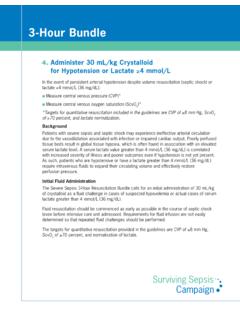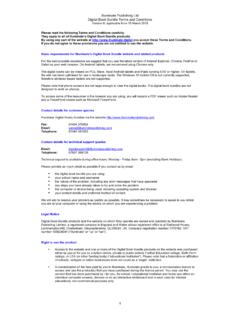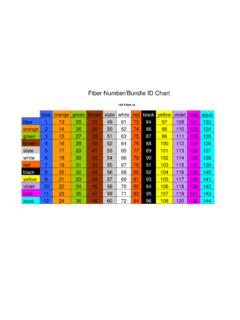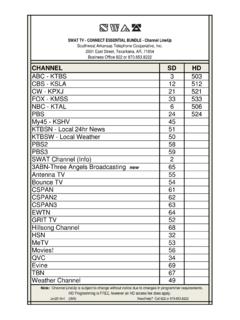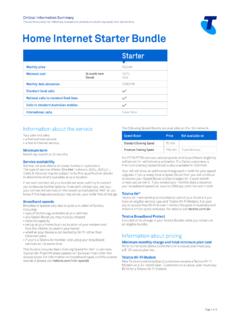Transcription of VAP Prevention Bundle Guidance for Implementation
1 IVAP Prevention BundleGuidance for ImplementationScottish Intensive Care Society Audit Groupii NHS National Services Scotland/Crown Copyright 2012 First published January 2008 Brief extracts from this publication may be reproduced provided the source is fully acknowledged. Proposals for reproduction of large extracts should be addressed to:ISD Scotland Publications Information Services Division NHS National Services Scotland Gyle Square 1 South Gyle Crescent Edinburgh EH12 9 EBTel: +44 (0)131-275-6233 Email: and typeset by: ISD Scotland PublicationsDocument draft of 1st versionDr Brian versionDr Brian CookTranslation ServiceIf you would like this leaflet in a different language, large print or Braille (English only), or would like information on how it can be translated into your community language, please phone 0131 275.
2 VAvoiding invasive ventilation ..viVAP Prevention Bundle ..11. Sedation is reviewed and, if appropriate, stopped each day ..22. Assess all patients for weaning and extubation each day ..43. Avoid the supine position and aim to have the patient at least 30o head up ..54. Use chlorhexidine as part of daily mouth care ..75. Use subglottic secretion drainage in patients likely to be ventilated for more than 48 hours ..8 Method of humidification ..9ivvIntroductionThe Ventilator Associated Pneumonia (VAP) Prevention Bundle and associated tools were first jointly published by SICSAG and Health Protection Scotland (HPS) in January 2008.
3 A review of the content against current available guidelines and evidence has now been undertaken by the Infection Control Team, HPS to ensure that the key recommendations are still accurate for the Prevention of VAP, primarily aimed at the Prevention of Healthcare Associated Infections (HAI). The aim of this care Bundle is to improve practice, alongside documented evidence of compliance with evidence based practice aimed at improving patient outcomes. This care Bundle has been agreed by experts in intensive care and infection control, from around Scotland. They have considerable experience in their own areas of care Bundle application and infection control through surveillance.
4 It is also supported by the Scottish Patient Safety Programme Recommending best practice of this type requires compromise and following pages explain the rationale and detail each Bundle element that can be measured against, however local adaptation may be deemed appropriate. Auditing compliance with Bundle elements should be undertaken and describing any account of valid clinical exclusions is essential. The full evidence base used to create this Bundle can be found at These measures are part of an overall strategy to reduce HAIs in intensive care which includes: Hand hygiene, Personal protective equipment, Environmental practice aimed at preventing VAP must be seen in the context of managing patients with respiratory failure and especially those who require invasive invasive ventilationSome patients with acute respiratory failure are suitable for non-invasive ventilation1.
5 Randomised Controlled Trials (RCTs) investigating the benefit of non-invasive ventilation have used primary outcomes such as invasive ventilator days, intensive care days and survival. There is good evidence that non-invasive ventilation improves these outcomes in patients with acute respiratory failure, especially those with an acute exacerbation of COPD, cardiogenic pulmonary oedema and the immuno-suppressed. Non-invasive ventilation may be associated with reduced rates of hospital-associated pneumonia, but the main benefit is in avoiding invasive , daily assessment of sedation requirement and the suitability for weaning and extubation helps reduce ventilator and ICU recommend consideration of non-invasive ventilation.
6 Daily assessment of sedation and daily consideration for weaning and extubation as part of an overall strategy for managing patients with acute respiratory ventilation and avoiding intubation should be considered in appropriate cases Improved outcome with initial non-invasive respiratory support trying to avoid intubation has been demonstrated in the following groups1: Cardiogenic pulmonary oedema, Acute exacerbation of Chronic Obstructive Pulmonary Disease, Immuno-compromised patients: Pneumocystis infection and solid organ transplant outcome with initial non-invasive respiratory support trying to avoid intubation has been demonstrated in: ICU patients who fail a trial of extubation2, Garpestad E, Brennan J, Hill NS.
7 Noninvasive Ventilation for Critical Care. Chest 2007; 132(2):711 Keenan SP, Powers C, McCormack DG and Block G. Non-invasive positive-pressure ventilation for post extubation respiratory distress: a randomized controlled trial JAMA 2002; 87(24):3238-44. 3. Esteban A, Frutos-Vivar F, Niall D et al. Non-invasive positive-pressure ventilation for respiratory failure after extubation. N Engl J Med 2004; 350 Prevention BundleThere are five key elements to this Bundle which if addressed together should minimise the risk of ventilator associated pneumonia. VAP rates should be part of an infection surveillance Sedation to be reviewed and, if appropriate, stopped each All patients will be assessed for weaning and extubation each Avoid the supine position, aiming to have the patient at least 30o head Use chlorhexidine as part of daily mouth Use subglottic secretion drainage in patients likely to be ventilated for more than 48 element is explained with references and exclusions on the following Sedation is reviewed and, if appropriate.
8 Stopped each dayRationaleA RCT of daily sedation breaks versus routine care demonstrated reduced duration of ventilation and intensive care unit stay in those patients having daily interruptions of sedation under the Guidance of the research RCT demonstrated that a nurse-led protocol reduced ventilator time5. This approach requires each ICU to examine their sedation practice and scoring and develop a system that allows a safe sedation hold policy, see example on page three from NHS Forth Valley. Note It is important to remember to review the patient s analgesic requirements if the sedation remains off. Measurement criteriaEnsure that sedation is reviewed and if appropriate stopped each day.
9 Exclusions1. Paralysed Patient with brain injury, sedated with possible ICP Patient who is difficult to ventilate - Patient who is difficult to oxygenate 70%O2 or PEEP Patient receiving therapeutic Patient receiving palliative/terminal NHS Forth Valley s sedation hold policy The following Guidance has been used successfully in NHS Forth breaks should ideally occur before 10am. If appropriate consider switching off sedation at the end of the night shift. In order to maintain patient and staff safety, liaise closely with the nurse in charge and colleagues. Sedative agents should be stopped, but not disconnected from the patient, Allow the patient to wake, If the patient is co-operative and able to understand commands leave the sedation off, Distressed or agitated patients require re-sedating, Recommence the sedation at half the previous rate, Administer boluses as appropriate / required to achieve Kress JP, Pohlman AS, O Connor MF, Hall JB.
10 Daily interruption of sedative infusions in critically ill patients undergoing mechanical ventilation. N Engl J Med 2000; 342:1471 Brook AD, Ahrens TS, Schaiff R et al. Effect of a nursing-implemented sedation protocol on the duration of mechanical ventilation. Crit Care Med 1999; 27(12): 2609 Quenot JP, Ladoire S, Devoucoux F et al. Effect of a nurse-implemented sedation protocol on the incidence of ventilator-associated pneumonia. Crit Care Med 2007; 35(9) Assess all patients for weaning and extubation each dayRationaleDaily screening of the respiratory function of ventilated patients followed by trials of spontaneous breathing in appropriate patients reduced the duration of mechanical ventilation and was associated with fewer complications than usual RCTs have demonstrated that weaning protocols reduce ventilator times8, criteriaEnsure that all patients are assessed for weaning and extubation each day.


